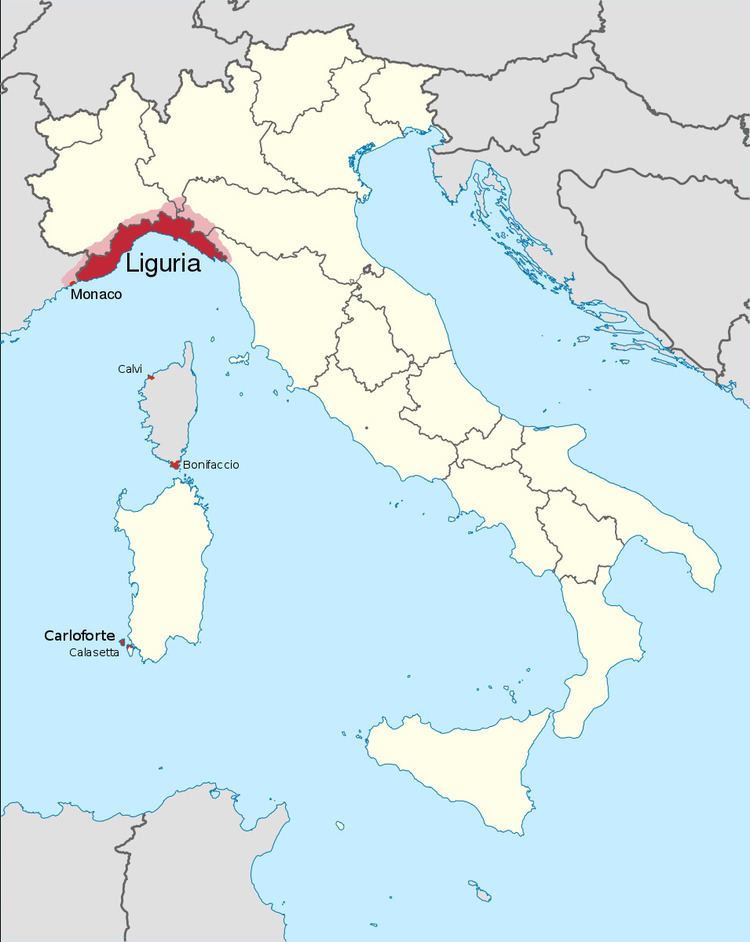Pronunciation [ˈliɡyre], [zeˈnejze] Native speakers 500,000 (2002) | Native to Italy, Monaco, France | |
 | ||
Region Italy:
Liguria
Piedmont (southern part of the Province of Cuneo and Province of Alessandria)
Lombardy (southern part of the Province of Pavia)
Emilia-Romagna (part of the Province of Piacenza and Province of Parma)
Sardinia (part of the Province of Carbonia-Iglesias)
Monaco
France:
Provence-Alpes-Côte d'Azur (part of Alpes Maritimes)
Corsica (part of Haute-Corse and Corse-du-Sud)
Argentina:
Buenos Aires (in the neighborhood of La Boca) Language family Indo-European
Italic
Romance
Western
Gallo-Romance
Gallo-Italic
Ligurian Dialects Genoese
Monégasque
Intemelio
Brigasc | ||
Ligurian (ligure or lengua ligure) is a Gallo-Romance language spoken in Liguria in Northern Italy, parts of the Mediterranean coastal zone of France, Monaco and in the villages of Carloforte and Calasetta in Sardinia. It is part of the Western Romance language continuum. The Genoese (Zeneize), spoken in Genoa, the capital of Liguria, is the language's prestige dialect on which the standard is based.
Contents
Ligurian has almost 500,000 native speakers, and is still widely spoken by many in Genoa and in many of the small towns and villages in the region. There are also many groups dedicated to the preservation of the language such as Associazione Culturale O Castello in Chiavari, which offers Ligurian (Genovese) language courses. Notable native speakers of Ligurian include Niccolò Paganini, Giuseppe Garibaldi, Christopher Columbus, Eugenio Montale, Giulio Natta, Italo Calvino, and Fabrizio De André.There is also a popular musical group, Buio Pesto, who compose songs entirely in the Genoese dialect.
There is a long literary tradition of Ligurian poets and writers that goes from the 13th century to the present, such as Luchetto (the Genoese Anonym), Martin Piaggio and Gian Giacomo Cavalli.
Geographic extent
Besides Liguria (Ligurian Liguria), the language is traditionally spoken in coastal, northern Tuscany, southern Piedmont (part of the province of Alessandria), western extremes of Emilia-Romagna (some areas in the province of Piacenza), in a small area of southern Sardinia (Italy), the Alpes-Maritimes of France (mostly the Côte d'Azur from the Italian border to and including Monaco), and in a township at the south of Corsica (France). It has been adopted formally in Monaco as the Monegasque language; or locally, Munegascu.
The Mentonasc dialect, spoken in the East of the County of Nice, is considered to be a transitional Occitan dialect to Ligurian; conversely, the Roiasc and Pignasc spoken further North in the Eastern margin of the County are Ligurian dialects with Occitan influences.
In Italy, the language has given way to Standard Italian and in France to French.
Description
Ligurian exhibits distinct Italian features but also has features of other Romance languages. No link between Romance Ligurian and the Ligurian language of the ancient Ligurian populations, in the form of a substrate or otherwise, can be demonstrated by linguistic evidence. There are, however, toponomastic derivations from ancient Ligurian.
Variants
Variants of the Ligurian language are:
Alphabet
The Ligurian alphabet has:
